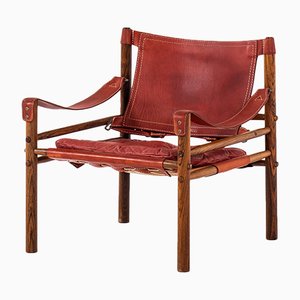
Designer Arne Norell was born in 1917 in Åsele, Sweden, and was active in the postwar era—at the height of international fascination with Scandinavian design. Little biographical information is available about his formative years, but we do know that he opened a furniture workshop in Stockholm in 1954. In 1958, he launched his eponymous manufacturing company, Møbel AB Arne Norell, on a two-acre farm in Småland. Through the course of his prolific career, this idyllic setting remained Norell’s central source of inspiration and the site where he designed and produced all of his own furniture until he passed away in 1971.
Norell is often praised for pioneering “conceptual” furniture, because he employed traditional materials—leather, turned wood, bentwood, and metal, for example—in unexpected forms, often with lyrical results. His designs have an affinity with those of Danish designer Kaare Klint (1888-1954), who, a generation before, brought time-honored, vernacular forms into modernist expression. In fact, Klint’s iconic Safari Chair (1933) inspired Norell to create the Sirocco Safari Chair (1964), which is lightweight, collapsible, and held together by leather support straps instead of glue or screws. Norell’s wood-framed Inka Armchair, Indra Sofa, and Ilona Sofa (design dates unverified) are likewise held together by leather.
While Norell’s designs found a solid market within his lifetime, his greatest recognition came posthumously: The British Furniture Manufacturers Association awarded Norell’s low-slung, steel-framed, leather-clad Ari Chair (1966) “Show Piece of the Year” in 1973. Norell’s pieces have become increasingly collectible in the 2010s.
Today, Norell’s daughter and son-in-law, Marie Norell-Möller and Thomas Möller, carry on his work, operating under the name Norell Møbel AB. In 2014, the company celebrated its 60th anniversary. It’s the only Swedish company that has continuously manufactured the entirety of Norell’s catalogue since the 1950s.
* Images courtesy of Norell Möbel AB

